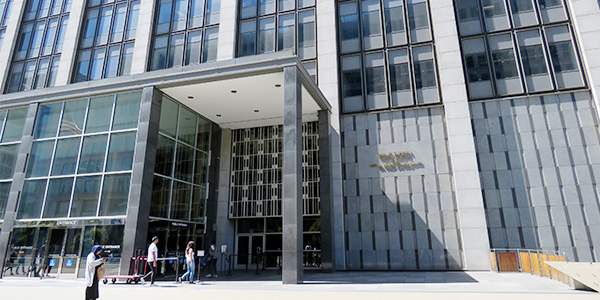By Hudson Sangree
The escalating battle between bondholders and shareholders to control Pacific Gas and Electric when it exits bankruptcy played out before federal Judge Dennis Montali on Monday, just as PG&E announced it could shut down power to much of Northern California this week to prevent wildfires.
PG&E said portions of 30 counties could be affected by the public-safety power shutoff including most of the urbanized San Francisco Bay Area with 7.75 million residents. The warning did not include the city of San Francisco, where PG&E is undergoing Chapter 11 reorganization as it faces billions of dollars in liability for earlier wildfires.
There was no mention of PG&E’s unprecedented announcement in Monday’s hearing in the U.S. Bankruptcy Court, where Montali often sounded skeptical of the effort by bondholders to end PG&E’s period of exclusivity — the time it has to file and solicit support for its Chapter 11 plan of reorganization. The bondholders hope to wrest control of California’s largest utility from its shareholders with their own plan to settle the claims of wildfire victims and others..
In exchange for a nearly $30 billion investment, the bondholders would gain a controlling stake in PG&E while wiping out the value of current shareholders’ stock.
Montali said repeatedly he didn’t think the fight over PG&E’s future was doing much good for the victims of wildfires started by PG&E equipment. Blazes in 2017 and 2018 blamed on PG&E included November’s Camp Fire, which killed 86 people and burned down the town of Paradise. Liability for the fires drove the utility into bankruptcy in January.
“Why should we in effect have a corporate control battle when we really ought to be taking care of the victims?” Montali asked attorney Abid Qureshi, who represents the bondholders, formally called the Ad Hoc Group of Senior Unsecured Noteholders.
Qureshi, like other lawyers, said the bondholders’ plan offered fire victims roughly $5 billion more than PG&E’s latest proposal — $13.5 billion compared to $8.4 billion — and would settle the cases without the delay of legal proceedings to estimate damages and to determine liability in the Tubbs Fire, which killed 22 people and destroyed part of the city of Santa Rosa in October 2017. Those proceedings are underway in federal and state court.
The bondholders’ plan recently won the support of the Official Committee of Tort Claimants, which represents fire victims in the bankruptcy case. Others now pushing to end PG&E’s exclusivity include the main group of bankruptcy claimants, called the Official Committee of Unsecured Creditors, as well as consumer watchdog The Utility Reform Network and the International Brotherhood of Electrical workers, PG&E’s largest union. (See Creditor Group Joins Call to End PG&E ‘Exclusivity’.)
PG&E has the support of a group of insurers and investors that hold about $20 billion in subrogation claims, which the company agreed to settle in mid-September for $11 billion. (See PG&E and Insurers Agree to Settle Wildfire Claims.)
Montali ruled Aug. 16 against the bondholders’ first bid to end exclusivity. In Monday’s hearing, he asked lawyers to tell him what had changed that would make him reverse course.
Qureshi argued that the increased support to end exclusivity was a major difference.
“Every creditor constituency in this case that has taken a position on whether to terminate exclusivity with one exception [the subrogation claimant] … is in favor of terminating exclusivity,” the attorney said. Because the bondholders’ plan also offers the subrogation claimants $11 billion, only PG&E and its shareholders are opposed to ending exclusivity, he contended.
Later in the hearing, lawyer Cecily Dumas told Montali that the fire victims she represents are willing to accept the $13.5 billion the bondholders have offered and also urged him to allow the bondholders’ plan to compete with PG&E’s proposal.
In response, the judge elaborated on his concerns about admitting the bondholders’ reorganization plan.
“I’m trying decide whether to listen to the pleas [from] you and everybody else … by even letting that other plan in,” he said. “To be blunt about it, my fear is that having the competing plan turns what was designed to protect the victims into a battle over corporate control … between two different money interests and has nothing to do with paying victims.
“Why do you want to be sitting there waiting to get your victims paid watching a corporate battle that has nothing to do with paying the victims?” he asked Dumas.
She replied that PG&E’s plan isn’t as well-funded as the bondholders’ proposal, and the utility may not be able to pay more than the $8.4 million it proposed.
“There’s risks associated with the debtors’ plan that are made easier by the bondholder plan frankly because they have more resources to throw at it.”
Montali said PG&E’s opening bid was unlikely to be its final offer. He said he would take the new motion to end exclusivity under consideration and issue a ruling later.
‘Strong and Dry’ Winds
Meanwhile, PG&E said meteorologists in its emergency operations center “continue to monitor a potentially widespread, strong and dry wind event Wednesday morning through Thursday afternoon. The event will impact northern, central, coastal and Bay Area counties across much of PG&E’s service area.”
PG&E is the latest of California’s three major utilities to use power shutoffs to prevent fires. San Diego Gas & Electric and Southern California Edison have used the tool for years during hot, windy conditions, though not on the scale PG&E announced Monday.
October and November are prime fire season in California, when air and vegetation are bone dry and powerful winds, including Southern California’s infamous Santa Ana winds, fan infernos.




